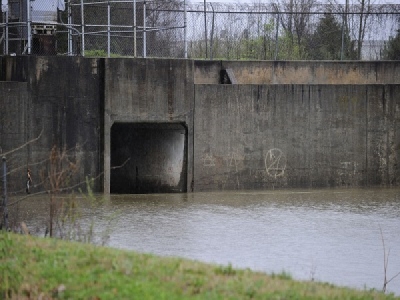
Posted on March 5, 2018
By Bayne Hughes, DecaturDaily.com
It could cost as much as $2.8 million to dredge Wilson Morgan Lake, create flood plains and take other corrective action to alleviate flooding issues in Southeast Decatur, an engineering consultant’s new report says.
Blake McAnally, of Pugh Wright McAnally Engineering Services, gave the City Council options last week that could help alleviate flooding issues in the neighborhoods near Decatur Country Club.
The council last summer commissioned the engineering firm to do the study — the third such study in the past 50 years by the city — for $30,000 because of the flooding of properties along Brush Creek near Country Club Road.
Two storms — on July 4, 2013, and Dec. 25, 2015 — led to the study because the 24-hour precipitation in each was 7.4 inches. They were considered “100-year floods” for Decatur, because there was only a 1 percent chance of that much daily accumulation in any given year.
The city has nine drainage basins, but the report focuses on reducing potential flooding in the Clark Spring and Brush Creek drainage basins.
Clark Spring flows east through Wilson Morgan Lake and joins Brush Creek at their confluence west of Country Club Road Southeast, just south of Flint Road and north of Stratford Road. The lake was built in 1988-89.
In Southwest Decatur, improvements are possible. There are flood storage options in three potential reservoir sites, five upland flood plain sites throughout the drainage basin, and one stream improvement area near the outlet of Brush Creek to Flint Creek.
These improvements would positively impact the flow of floodwaters, but returns on investment would be limited, McAnally said.
The options presented to the council:
– Removing the five boards in Wilson Morgan Lake’s control weir prior to a storm event would lower the lake level by 18 inches. Timing is critical to achieve maximum effect and might take 24 hours to accomplish.
McAnally estimated this option would cost about $3,105 annually for supplies and labor.
– Refurbish the lake’s pump at the control weir at a one-time cost of $10,000, and construct a fish hold for $11,125. He estimated the annual maintenance with a two-man monitoring crew would be $2,940.
Street and Environmental Services Director Rickey Terry said one of his crew members got the pump running, but someone would have to stay nearby with oil to keep it running.
McAnally said the pump could lower the lake level by 3 or 4 feet within six to eight hours. This could impact aquatic life, so a holding area of more than 4 feet could be added to limit the adverse impact on the fish and other aquatic life.
– The city could install three fountain pumps at the lake for about $6,000, with an estimated annual maintenance and electricity cost of roughly $3,180.
– Construct a 7- to 8-foot wide flood plain south of Brookmeade Road Southeast for $433,366. McAnally said this would impact about four or five homes.
This is the one area near the intersection of Clark Spring and Brush Creek that restricts the water’s flow.
“This could reduce the water level by 12 to 18 inches on the north side of Stratford Road,” McAnally said.
His estimate includes engineering and managing the project, clearing and lowering a 2-acre area, re-sodding the property and rebuilding a driveway and bridge that the resident uses to access his home.
A 15-percent contingency is included in his estimate. An estimate for the city obtaining a right of way through the property to build the flood plain was not included.
– Clear and clean an area on the Wheeler Wildlife Refuge downstream on Brush Creek for $75,900.
– Dredge about 25,000 cubic yards of sediment from the lake to change its elevations to 566 feet above sea level for an estimated $2.37 million. This would drop the lake level between 2 and 3 feet, but the city wouldn’t see a significant gain in dealing with the floor water with this tactic.
Dredging 80,000 cubic yards of sediment is possible, but it would expensive. This would also advance plant growth that would ultimately impede water flow, be unsightly and negatively impact aquatic life, the report says.
McAnally said he wouldn’t recommend any additions to the lake for recreation other than possibly a floating dock because any addition would reduce its capacity.
– Finish the lake as originally planned by removing an existing berm on the north side of the lake for an estimated $2.8 million.
This would reduce the discharge rate by 15 percent and lower the flood stage elevation about 7 inches.
A major problem with this option is several ballfields would have to be removed, McAnally said.
Councilman Billy Jackson said there are flooding issues throughout the city, but he appreciates McAnally’s suggestions. He said finances will keep the city from doing all of the options.
“He offered us some solutions that surprisingly were not overly exorbitant,” Jackson said. “I would start with the pump and make sure it’s working.”
Council President Paige Bibbee said the only viable options in her opinion are the Brookmeade Road option, removal of the boards from the lake wall and repairing the lake pump.
Bibbee said she doesn’t believe the refuge would let the city create a flood basin because of fear it could have a negative impact on wildlife.
“The dredging is not necessary,” Bibbee said. “And the other options don’t add enough time to aid in reducing the flooding.”
Councilman Chuck Ard said he is OK with McAnally’s recommendation not to create additional drainage basins in Southwest Decatur even though this is in his District 5.
“They just won’t have enough impact to justify the expense,” Ard said.
Source: DecaturDaily.com





